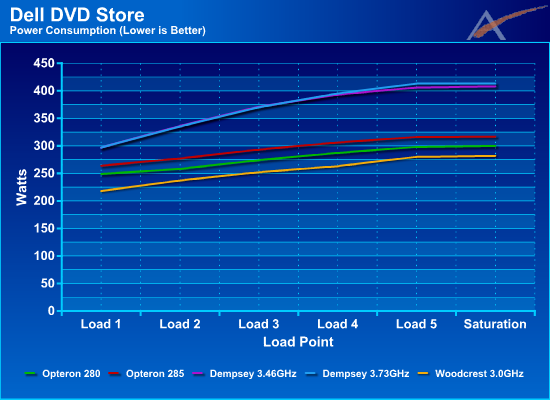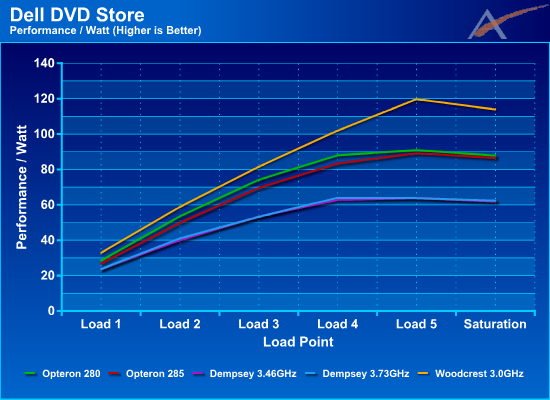Intel Woodcrest: the Birth of a New King
by Jason Clark & Ross Whitehead on July 13, 2006 12:05 AM EST- Posted in
- IT Computing
Dell Test results

At the first three load points all platforms are within 4% of each other. At the fourth load point the spread opens up and Woodcrest leads the Opteron 285 by 5% and Dempsey 3.73 by 6%. Finally, at the fifth load point, Woodcrest is able to lead the Opteron 285 by 19% and Dempsey 3.73 by 27%. It is interesting to note in this graph, and other upcoming performance graphs, that Woodcrest scales linearly to the fifth load point but the others stop scaling linearly between the third and fourth load points.

Woodcrest is clearly the lowest consumer of power and leads the Opteron 285 by 11%-17%, and Dempsey 3.73 by 27%-33%. FB-DIMMs do consume more power than regular DDR2 memory, which partially offsets some of the advantage of the Core architecture.

When we combine performance and power and come up with Performance/Watt we get a very different picture. In this graph we see that Woodcrest is the clear leader at all load points and leads the Opteron 285 by 17% - 34%, and Dempsey 3.73 by 39%-88%. It is also interesting to note that the Opteron 280 outperforms the Opteron 285 on a Performance/Watt measure while Dempsey performance scales almost linearly with power. This often is an indication that the architecture is reaching its clockspeed limits, which is certainly the case as the only faster dual core K8-based chip presently available is the FX-62.

At the first three load points all platforms are within 4% of each other. At the fourth load point the spread opens up and Woodcrest leads the Opteron 285 by 5% and Dempsey 3.73 by 6%. Finally, at the fifth load point, Woodcrest is able to lead the Opteron 285 by 19% and Dempsey 3.73 by 27%. It is interesting to note in this graph, and other upcoming performance graphs, that Woodcrest scales linearly to the fifth load point but the others stop scaling linearly between the third and fourth load points.

Woodcrest is clearly the lowest consumer of power and leads the Opteron 285 by 11%-17%, and Dempsey 3.73 by 27%-33%. FB-DIMMs do consume more power than regular DDR2 memory, which partially offsets some of the advantage of the Core architecture.

When we combine performance and power and come up with Performance/Watt we get a very different picture. In this graph we see that Woodcrest is the clear leader at all load points and leads the Opteron 285 by 17% - 34%, and Dempsey 3.73 by 39%-88%. It is also interesting to note that the Opteron 280 outperforms the Opteron 285 on a Performance/Watt measure while Dempsey performance scales almost linearly with power. This often is an indication that the architecture is reaching its clockspeed limits, which is certainly the case as the only faster dual core K8-based chip presently available is the FX-62.










59 Comments
View All Comments
Lonyo - Thursday, July 13, 2006 - link
What's the fastest Opteron dual core CPU you can buy?What's the fastest Woodcrest CPU that will be released?
AMD don't make anything faster than 2.6GHz, so it doesn't really matter what speed Intel have to be at to beat it, they beat it with their top end part. And the Opteron is nearing its end (at 90nm), Woodcrest is new, so it will go faster probably, same as 65nm Opterons will go faster.
Woodcrest is not behind Opteron, it is better per watt, and the high end Woodcrest beats the high end Opteron. Enough said. Whether Intel is clock for clock better or not still doesn't matter. They are better, and if they are not better clock for clock, it doesn't seem to matter because, again, they have higher clocks.
Spoonbender - Thursday, July 13, 2006 - link
"What's the fastest Woodcrest CPU that will be released? "Umm.... None?
Does that mean AMD beats Intel by an infinite margin then?
True, if Intel has a 3ghz part out, and AMD only has 2.6, then it makes sense to compare these two.
But for now, let's just keep in mind that Intel doesn't have a 3ghz part out. They don't have a 2.6GHz part either. We are still comparing an unreleased product to one that has been out for a while.
Cooler - Thursday, July 13, 2006 - link
Their on new egg right now...http://www.newegg.com/Product/ProductList.asp?Subm...">http://www.newegg.com/Product/ProductLi...rchInDes...
xtremejack - Thursday, July 13, 2006 - link
You should note the way the two processors are compared here. Both are dual-CPU systems. Intel's FSB based system architecture means lower system bandwidth than AMD's DirectConnect architecture. The Opteron's have an on-die memory controller and a point-to-point interconnect. I am sure if you put Woodcrest on a Paxville system, you would see significantly worse performance. The 3.0Ghz Woodcrest is probably capable of a bit more performance, but the lower bandwidth FSB does not help it reach its full potential. Also coupled with the fact that FB-DIMMS have more latency than standard DDR2 means the Woodcrest isn't at a serious advantage compared to the Opteron system.Bottom-line system performance for the Woodcrest processor is still 5-20% better than Opteron. But thats way better than being 30% lower during Paxville days.
Now Conroe does not have all these complications that Woodcrest has, thats why you may see better performance advantage, also since it is a single-CPU solution, the system architecture is much simpler.
swtethan - Thursday, July 13, 2006 - link
how many people running servers are going to overclock their system? :Dfitten - Thursday, July 13, 2006 - link
Zero. I'd fire any IT person on the spot if I found out they had overclocked a production server.FesterOZ - Thursday, July 13, 2006 - link
I find this article somewhat surprising in tone. My company is a Fortune 500 and a big Dell shop so we have had access to Woodcrest workstations and servers for testing for a while. We have also tested these vs HP 9300 Athlon based Workstations and vs Sun x4100 servers and HP DL385s. Based on our tests which involve business applications, trading applications, etc., the performance of Woodcrest vs the Athlons is slightly better (about 5-10%). Nothing to really rave about, especially when its the latest Intel designs on 65nm. This actually disappointed our in-house Dell groupies, especially since they were comparing the top of the line new CPU design from Intel vs AMD's older platform. As a result we are moving away from Dell simply because they do not offer choice of CPU's at the moment and into HP's world, with our first purchase being 3 full chassis of AMD blade servers.IMHO, its now a two baron world with a missing king, each with strenghts and weaknesses.
Kiijibari - Thursday, July 13, 2006 - link
>IMHO, its now a two baron world with a missing king, each with strenghts and weaknesses.Yes I back that opinion.
Woodcrest is hampered by its FBDs. While it delivers much better bandwidth, it has worse latencies. Furthermore the 4 MB L2 cache & Core2 prefetch does not help that much in a multithreaded server environment, than in the average desktop application area.
What I want to say is, that the performance difference between Conroe/Athlon64 will be bigger than that between Woodcrest/Opteron.
First "tests"( I was told by an administrator of a huge financal institute) also showed a Woodcrest performace lack with gcc compiled 64bit applications. Are some of your applications 64bit, too ? It would be interesting, to get more 64bit statments. For some reason, there are none from Intel so far ...
cheers
Kiijibari
Spoonbender - Thursday, July 13, 2006 - link
Yes, I've been wondering about 64-bit performance too. Intel hasn't mentioned it with a word, but I hope they've made a decent implementation this time around.duploxxx - Thursday, July 13, 2006 - link
no they didn't, still the same as in the Netburst. some small 64bit testing has been done on XS forums seeing a core architecture gaining 17-18% performance on a 64bit os + program like 64bit cinebench. the opty 940 gained 31-38%